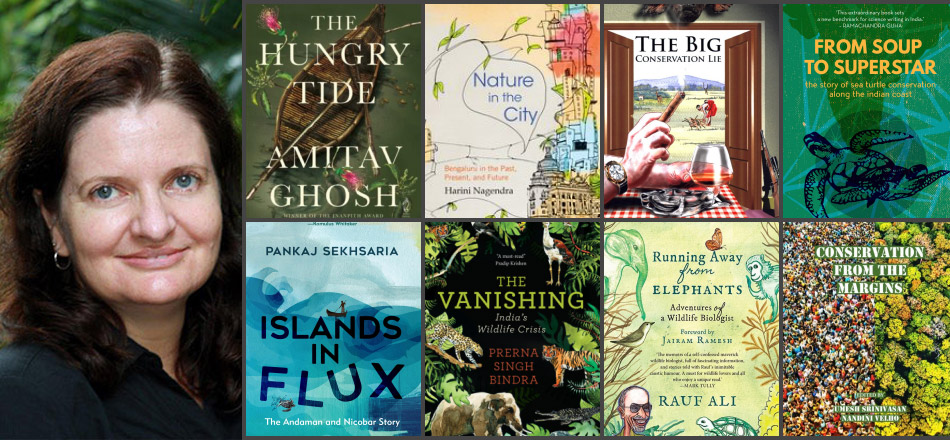Andrea D. Phillott, Professor in Environmental Studies, teaches Conservation Biology, Ecology, and Environmental Studies at FLAME University, Pune. In this article, she writes about an innovative approach she has followed to develop disciplinary literacy in her students viz., assigning them readings from popular literature, both fiction and non-fiction, pertaining to conservation science.
For university educators, one of the goals is to develop disciplinary literacy — the ability to read, write and communicate ideas in the discipline — in our students. Students develop disciplinary literacy during in-class activities (especially active learning activities as described here) complemented by out-of-class activities including assigned readings.
Traditionally, educators in the sciences have assigned readings from textbooks or research articles whose primary purpose is to communicate information or ideas. However, these sources have been described as challenging for readers unfamiliar with the technical language (‘jargon’) and writing structure (such as the IMRAD structure of research papers) and are often written in the passive voice.
In comparison, popular science writing presents less technical writing in an active voice, and places greater emphasis on the relevant actors and their thoughts and actions. Popular non-fiction literature with complementary learning activities have been used for assignments in undergraduate courses on general biology, microbiology (here and here), genetics, neurobiology, sensation and perception, the biology of cancer, biochemistry, biotechnology, organic chemistry, and the nature of science.
In addition, one published study investigated the use of popular literature in a course on conservation biology wherein students read the book ‘Tigerland and other Unintended Destinations’ by Eric Dinerstein (Island Press, 2005). The authors found that students made connections between the reading and conservation concepts and practices discussed in class and regarded the characters as role models.
Interested to see how reading popular literature could facilitate student learning in my own courses but hesitant to assign a single book because of student’s varied interests, I planned a different approach.
I provided final year students studying the course ‘Conservation Biology’ during their Bachelor of Arts in Environmental Studies with a list of suitable books (ensuring close to equal proportions of male and female and national and international authors) available in the University library. However, they could also read a book from their personal collection.
My recommendations included the species-centric ‘From Soup to Superstar: The Story of Sea Turtle Conservation Along the Indian Coast’ by Kartik Shanker (HarperLitmus, 2015) and more species diverse ‘The Vanishing: India’s Wildlife Crisis’ by Prerna Singh Bindra (Viking, 2017). Other books were place-based; ‘Nature in the City: Bengaluru in the Past, Present, and Future’ by Harini Nagendra (Oxford University Press, 2016) and ‘Islands in Flux: The Andaman and Nicobar Story’ by Pankaj Sekhasaria (HarperCollins Publishers India, 2017) encouraged students to consider familiar locations through a conservation lens.
Exploration of conservation experiences was possible through memoirs, such as ‘Running Away from Elephants: The Adventures of a Wildlife Biologist’ by Rauf Ali (Speaking Tiger Books, 2018), or fictional works, including ‘The Hungry Tide’ by Amitav Ghosh (HarperCollins Publishers, 2004). Books examining conservation practice, such as ‘The Big Conservation Lie: The Untold Story of Wildlife Conservation in Kenya’ by John Mbaria and Mordecai Ogada (Lens & Pens Press, 2016) and ‘Conservation from the Margins’ by Umesh Srinivasan and Nandini Velho (The Orient Blackswan, 2018) had the potential to inspire lively, but thoughtful, conversation and debate.
Students read at least one chapter a week and shared a 350 – 500 word reflection about how the content related to Conservation Biology course topics (including threats, population declines, and conservation actions) in an online class forum for everyone to read. Student reflections also contributed to their final grade for the course.
At mid-semester, students provided feedback on the activity using an anonymous survey and gave their consent for me to share the following responses. On a scale of ‘Very limited’ to ‘Excellent’, most students described their learning gains in building knowledge about concepts and applications in the discipline of conservation biology as ‘Strong’, and in relating course content to actual situations and making connections between conservation biology and other disciplines as ‘Excellent’. Students’ self-assessed learning gains in these areas were greater than what they reported after other course assignments during which they read and summarised primary research literature.

However, the most valuable outcome of reading popular literature was beyond that of building knowledge about concepts and issues in conservation biology. Most students reported ‘Excellent’ learning gains in developing a personal understanding of challenges in the discipline, understanding the experiences of people working in conservation biology, and identifying skills such as photography which aid conservationists in their work. Of similar value to them was the development of a regular reading practice, albeit one that was hard to maintain at times when assessment was due for multiple courses.
In response to this feedback, I reduced the reading reflection requirement from weekly to fortnightly so as to maintain the sense of anticipation, interest, motivation, and engagement they described as the aspect of the activity they found the most rewarding. I did not want such positive emotions to be overwhelmed if the reading reflection became just another task to complete each week.
The students’ feedback indicated reading popular literature contributed to the development of both disciplinary literacy in conservation biology (as discussed here, here and here) and a community of learners as students referred each other to chapters they believed would be of interest to their peers or linked to topics and assessment for other courses. I plan to continue the reading and reflections (which contribute to their final grade) in future years and strongly encourage educators in other science courses and disciplines to consider how it might benefit their students.
- Prof. Andrea Phillott, Professor - Environmental Studies
*Views expressed are personal.
(Source: https://indiabioscience.org/columns/education/reading-popular-literature-helps-build-disciplinary-literacy-an-example-from-conservation-science)


